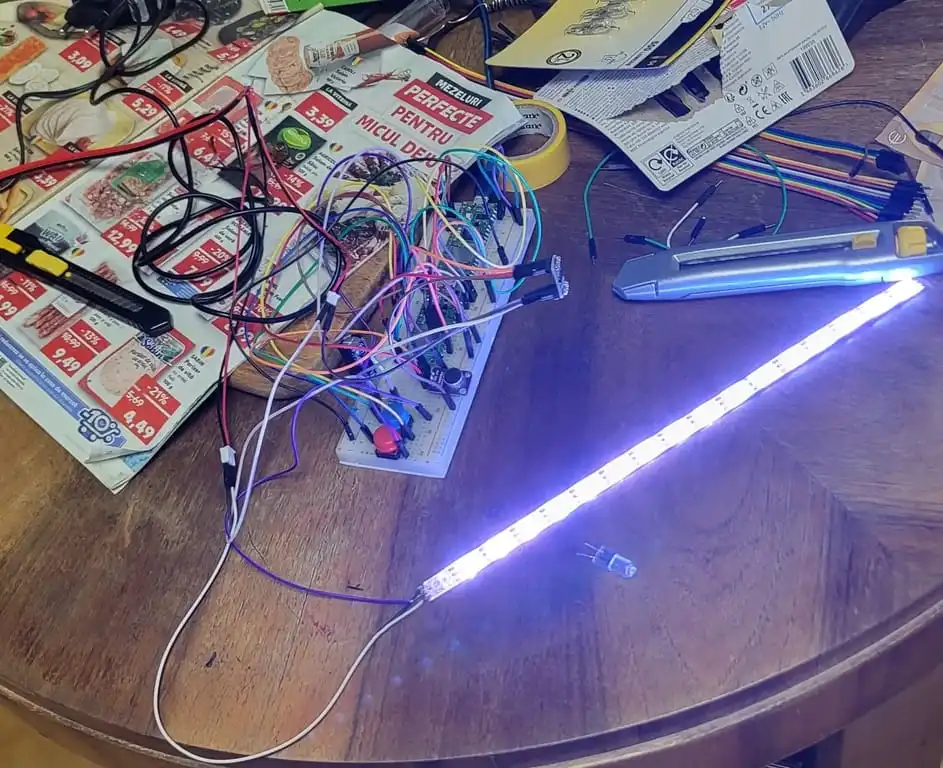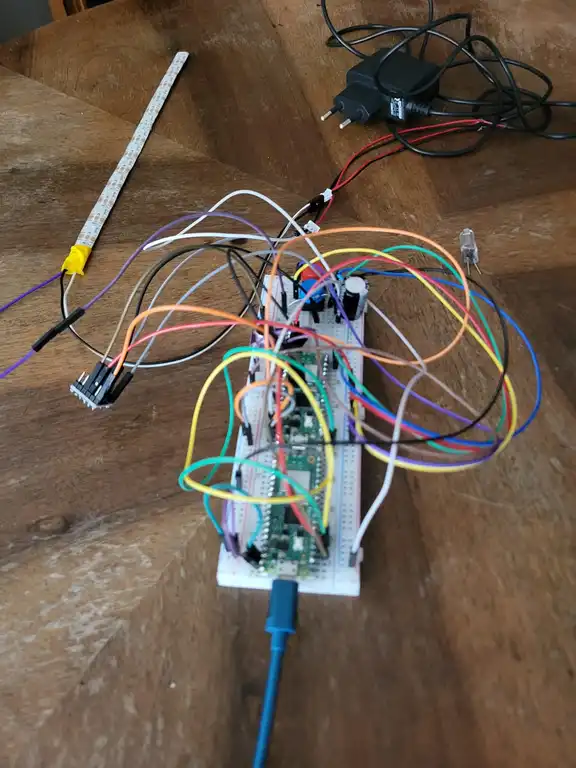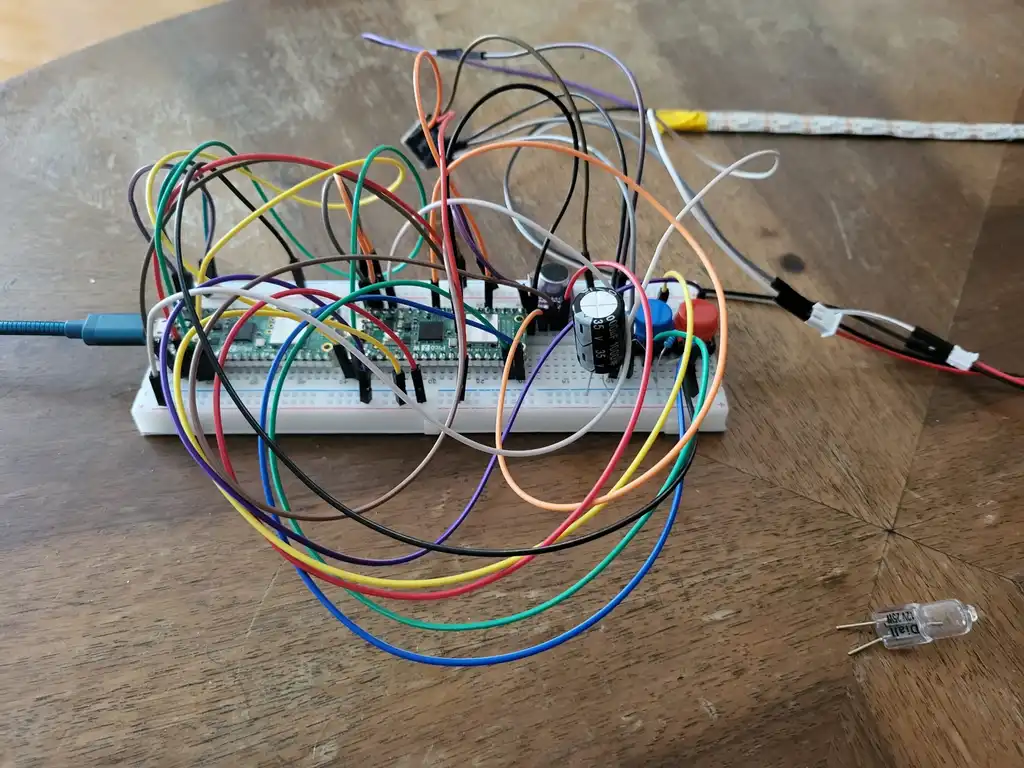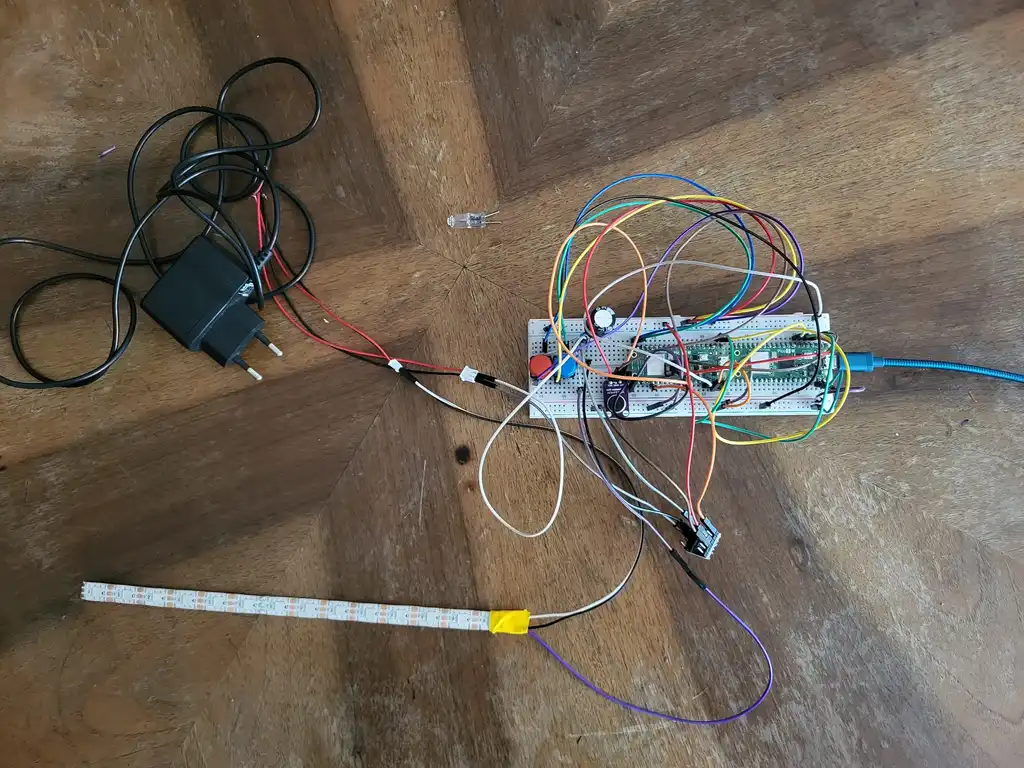Music Lights
A Raspberry Pi Pico system that synchronizes LED lighting with music
Author: Antonio-Christian Carazeanu
GitHub Project Link: link_to_github
Description
Music Lights is a project that uses a Raspberry Pi Pico to control an LED strip based on live music input. A microphone captures ambient audio, and a signal processing algorithm detects the beat and dominant frequencies. The LEDs react in real-time by changing color and brightness, creating an immersive audio-visual experience.
Motivation
The idea behind this project came from a desire to blend music with dynamic visual effects. I wanted to explore how embedded systems can process audio and produce synchronized lighting, making music more interactive and engaging.
Architecture
The project is composed of the following main components:
- Microcontroller: Raspberry Pi Pico running real-time firmware using Embassy.
- Audio Input: MAX4466 Microphone module connected to the Pico's ADC, capturing audio signals.
- Signal Processing: Algorithm performing FFT using the
microfftlibrary to analyze frequencies. - LED Control: LED strip controlled via the RP2040's PIO unit using
embassy-rpand a compatible WS2812 PIO program (likews2812-pioor similar). Requires a Logic Level Shifter (3.3V to 5V) for the data signal. - Output: WS2812 LED strip visualizing music dynamically.
Connections:
- Microphone Analog Out → Pico ADC GPIO (e.g., GPIO26)
- Pico GPIO (PIO Output) → Level Shifter (Low Voltage Input)
- Level Shifter (High Voltage Output) → LED Strip Data In (via ~330Ω resistor)
- Buttons → Pico GPIO Inputs (with 10kΩ pull-up/pull-down resistors)
- Pico USB → Power (for Pico) and programming
- Separate 5V Power Supply → LED Strip (+5V, GND)
- Separate 5V Power Supply → Level Shifter (HV Pin)
- Common Ground: Crucial connection between Pico GND, Level Shifter GND, and the Separate 5V Power Supply GND.
Log
- Week 5 - 11 May: Set up the Raspberry Pi Pico and assembled the main hardware components.
- Week 12 - 18 May: Completed the full hardware assembly and tested each component with example code.
- Week 19 - 25 May:
Hardware
- Raspberry Pi Pico W (x2 - one for development/debug)
- WS2812 LED Strip (3x 10cm segments = 18 LEDs)
- MAX4466 Microphone Module
- Logic Level Shifter Module
- Jumper wires (M-M, M-F) and Breadboard
- USB cables (for Pico power/programming)
Schematics
Project Photos





Bill of Materials
| Item | Quantity | Unit Price | Total Price |
|---|---|---|---|
| Jumper Wires for Breadboard | 1 | 7.99 RON | 7.99 RON |
| Raspberry Pi Pico W | 2 | 39.66 RON | 79.32 RON |
| Breadboard HQ (830 tie points) | 1 | 9.98 RON | 9.98 RON |
| White Pin Header 2.54 mm (40p) | 3 | 0.99 RON | 2.97 RON |
| Colored Jumper Wires Female-Male (40p, 15 cm) | 1 | 7.99 RON | 7.99 RON |
| Electrolytic Capacitor 1000 µF, 35 V | 1 | 2.99 RON | 2.99 RON |
| Electrolytic Capacitor 470 µF, 50 V | 1 | 0.79 RON | 0.79 RON |
| USB Cable | 1 | - | - |
| Addressable LED Strip WS2812, 10 cm (60led/m) | 3 | 2.69 RON | 8.07 RON |
| Button 12x12x7.3 mm | 2 | 1.10 RON | 2.20 RON |
| Button Cap 12x12x7.3 mm, Blue | 1 | 0.34 RON | 0.34 RON |
| Button Cap 12x12x7.3 mm, Red | 1 | 0.34 RON | 0.34 RON |
| MAX4466 Microphone Module with Amplifier | 1 | 7.18 RON | 7.18 RON |
| 4-Channel Logic Level Converter Module | 1 | 4.00 RON | 4.00 RON |
| 330 Ω Resistor | 2 | 0.12 RON | 0.24 RON |
| 10k Ω Resistor | 1 | 0.13 RON | 0.13 RON |
| Sursă alimentare 5V | 1 | 23.38 RON | 23.38 RON |
| Conector DC mamă | 1 | 2.07 RON | 2.07 RON |
| Conector JST PH2.0 2P | 2 | 2.00 RON | 4.00 RON |
| Jumper Wires Male-Male (40p, 30 cm) | 1 | 8.00 RON | 8.00 RON |
| Conector pentru LED | 1 | 2.99 RON | 2.99 RON |
Estimated Total: ~ 173.27 RON (excluding USB cables)
Software
This list details the recommended Rust crates for the "Music Lights" project using the Embassy async runtime on the Raspberry Pi Pico.
| Library | Description | Usage |
|---|---|---|
embassy-executor | Core asynchronous task executor. | Runs all concurrent operations. |
embassy-time | Async time primitives (Delay, Timer, Instant). | Essential for timing and scheduling. |
embassy-sync | Async synchronization tools (Mutex, Channel, Signal). | Enables safe data sharing between async tasks. |
embassy-rp | HAL for RP2040 peripherals (ADC, GPIO, DMA, SPI, etc.). | Async access to hardware on the RP2040. |
embedded-hal | Standard HAL traits. | Used by embedded drivers like ws2812-spi. ([Docs.rs][1]) |
embedded-hal-async | Async HAL traits. | For async control of peripherals like SPI, I2C, etc. |
ws2812-spi | SPI-based driver for WS2812 & SK6812, implements SmartLedsWrite. | Sends LED data over SPI to WS2812 strips. ([Crates][2], [Docs.rs][1]) |
smart-leds | Utilities and types (RGB8, effects, gamma, brightness). | Defines LED colors and visual effects. ([Docs.rs][3], [Crates][4]) |
smart-leds-trait | Traits for smart LED drivers (SmartLedsWrite). | Enables calling write() on Ws2812<SPI>. ([Crates][5]) |
microfft | no_std FFT implementation (Radix-2 in-place). | Real-time audio frequency analysis for LED effects. ([Crates][6]) |
libm | Pure Rust implementations of C math functions (sqrt, powf, etc.). | Required for FFT math operations and signal processing. ([Docs.rs][7]) |
cortex-m | Access to ARM Cortex-M core peripherals. | Used for low-level embedded operations. |
cortex-m-rt | Minimal runtime for Cortex-M. | Defines program entry and exception vectors. |
panic-probe / panic-halt | Panic handlers for embedded targets. | Choose one; panic-probe works well with defmt. |
defmt | Efficient logging for embedded (RTT). | Enables lightweight debugging output. |
defmt-rtt | RTT backend for defmt. | Enables real-time logging via debug probe. |
embedded-io | Standard I/O traits. | Enables cross-crate I/O compatibility. |
embedded-io-async | Async I/O traits. | Used for async communication drivers. |
heapless | no_std data structures (Vec, String, etc.). | Useful for fixed-size buffers without dynamic allocation. |

